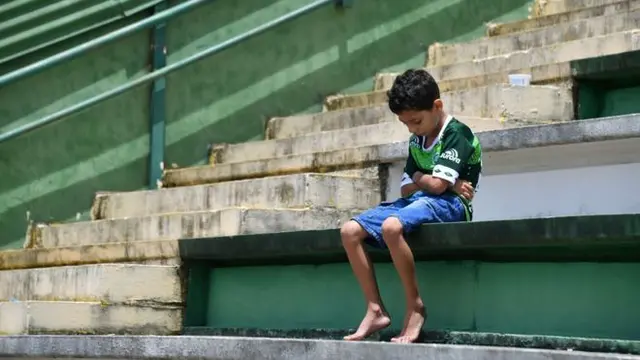Only six of the 77 people on board the charter plane, carrying members of the Chapecoense team, survived the crash.
The team were flying to what was billed as the biggest match in their history - the final of the Copa Sudamericana.
Their opponents, Colombian team Atletico Nacional, have offered to concede the game to ensure Chapecoense are declared the champions.
In a tweet, the club also asked that fans to turn up to their stadium at the time which the game was scheduled, dressed in white.
In a joint statement, Brazilian first division football teams have offered to lend players to Chapecoense free of charge, and asked the league to protect the club from relegation for the next three years.
Several leading footballers, from Barcelona stars Lionel Messi and Neymar, to Manchester United's Wayne Rooney, have also paid tribute to the players, who had become an unlikely success story in recent years.
Colombian aviation officials said there were also 21 journalists on board, and that both flight recorders have been recovered.
What happened?
The plane lost contact with ground controllers as it approached Medellin at about 22:15 on Monday (03:15 GMT on Tuesday), after the pilot reported an electrical fault. It came down in a mountainous area.
The number of those on board was first said to be 81, but Colombia's disaster management agency later said four people on the passenger list did not board the plane.
Three of the six survivors are footballers:
Defender Alan Ruschel, who suffered spinal injuries
Defender Helio Zemper, who has injuries to his skull and chest
Reserve goalkeeper Jakson Follman, who has unspecified injuries
Rescue workers stand at the wreckage site of a chartered airplane that crashed in a mountainous area outside Medellin, Colombia, Tuesday, Nov. 29, 2016. Photo: AP
Goalkeeper Marcos Padilha, also known as Danilo, was pulled alive from the wreckage but he later died in hospital.
Of the 21 journalists on board, six worked for Fox Sports Brasil, and a number of others for the Globo media organisation.
Three British investigators are travelling to Colombia to help look into the cause of the crash.
Who are Chapecoense? - Luis Barrucho, BBC Brasil
Shortly before boarding in Sao Paulo, Chapecoense manager Cadu Gaucho, 36, appearedin a video posted on the team's Facebook site[in Portuguese] describing the trip to Medellin as "the club's most important to date".
Playing in the final of the Copa Sudamericana was to be the highlight of a glorious season for the team from a small city of less than 200,000 inhabitants in the state of Santa Catarina.
Founded in 1973, the team has been playing in Brazil's Serie A since only 2014 but is currently ninth ahead of much more famous and established teams such as Sao Paulo, Fluminense and Cruzeiro.
Last week, it became the first Brazilian team in three years to make it to the final of the Copa Sudamericana, South America's second most important club competition, after beating Argentine side San Lorenzo.
One of the founders of the club, Alvadir Pelisser, told BBC Brasil the tragedy had put an "end to everyone's dream". "We were a family, I'm shocked," he added.
What has the reaction been?
Brazilian President Michel Temer announced three days of national mourning, and top Spanish clubs Real Madrid and Barcelona held a minute's silence at the beginning of their practice sessions.
Rescue teams recover the bodies of victims of the LAMIA airlines charter that crashed in the mountains of Cerro Gordo, municipality of La Union, Colombia, on November 29, 2016. Photo: APF/Getty Images
Chapecoense crest blacked out as a mark of respect and mourning. Photo: Twitter
Chapecoense's goalkeeping coach Marcelo De Quadros Kunst stayed in Brazil with players who did not travel to Colombia.
He told the BBC: "We see wives fainting, ambulances taking them to the hospital, family members holding on to football boots left behind."
Argentine forward Alejandro Martinuccio was one of those who had to stay behind. "I was saved because I got injured," he told Argentina's La Red radio.
"I feel profound sadness. The only thing I can ask is prayers for the companions who were on the flight."
The scene in Chapeco - Camilla Costa, BBC Brasil
Rescue teams recover the bodies of victims of the LAMIA airlines charter that crashed in the mountains of Cerro Gordo, municipality of La Union, Colombia, on November 29, 2016. Photo:AFP/Getty images
Chapecoense crest blacked out as a mark of respect and mourning. Photo: AFP
It's not unusual to see Brazilians wearing their team's shirt. But today in Chapeco, the gesture has a different meaning.
Since the early hours of the morning, men and women, young and old, have been coming to Chapecoense's stadium, Arena Conda.
Schools let their students go, shops remained closed.
People pay tribute to the players of Brazilian team Chapecoense Real who were killed in a plane accident in the Colombian mountains, at the club. Photo: AFP
Wearing green and white, the colours of the team, they stare at the empty field, still unable to believe the tragedy that took place.
"They were such humble boys. We all knew them," said supporter Djair Hipolito. "They took the time to talk to us, take photos, visit people in the hospital. I know that other teams are not like this."
"We should be celebrating now", he says. Their team was finally at the top, one match away from their first international title.
Now, the fans just sit in silence and wait for their boys to come home. "Do you know anything about the bodies?" a woman asks me. "Do you think the service will be here in the stadium?"
(BBC)
 简体中文
简体中文

